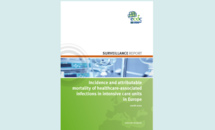Incidence and attributable mortality of healthcare-associated infections in intensive care units in Europe, 2008-2012
The report provides a comprehensive update of the epidemiology of pneumonia, bloodstream infections and urinary tract infections European ICUs as well as important reference data for European ICUs performing surveillance of ICU-acquired infections, allowing them to compare and interpret results from local surveillance using the ECDC HAI-Net surveillance protocol. It also provides for the first time estimates of attributable mortality and excess length of stay due to these infections in European ICUs.
Executive summary
Patients admitted to intensive care units (ICUs) are at high risk of acquiring infections because of their underlying illness and frequent exposure to invasive devices. Targeted surveillance of healthcare-associated infections (HAIs) in ICUs is an essential component of hospital infection prevention and control programmes, in particular when implemented as part of a national or regional surveillance network. Participation in ICU surveillance in Europe has increased steadily from 897 ICUs in 13 countries in 2008 to 1 247 ICUs in 15 countries in 2012. The three most frequent ICU-acquired infections, pneumonia, bloodstream infection and urinary tract infections, were included in the surveillance. Using matched cohort analysis, the total burden in ICUs in the EU/EEA countries of these three types of infections combined was estimated at 8 650 attributable deaths and 3.43 million extra days of ICU stay per year during 2008–2012. ICU-acquired infections thereby constitute a substantial burden in acute care hospitals in the EU/EEA with large public health and economic consequences.
Pneumonia
Pneumonia was reported in 6.1% patients staying more than two days in an ICU in 2008–2012, accounting for an estimated total of 157 014 patients with at least one ICU-acquired pneumonia in EU/EEA ICUs each year. The number of patients that die every year as the direct consequence of ICU-acquired pneumonia was estimated at 5 495 (attributable mortality of 3.5% [95% confidence interval 2.6–4.3%]). Patients with ICU-acquired pneumonia were estimated to stay on average 14 days longer in an ICU, accounting for an estimated total of 2.2 million days of excess ICU stay in EU/EEA acute care hospitals every year. The device-associated pneumonia rate decreased significantly from 13.6 to 10.2 intubation-associated pneumonia episodes per 1 000 intubation days in 2008 and 2012 respectively, with the strongest decrease in Spain, where it coincided with a coordinated prevention campaign. Microorganisms isolated in ICU-acquired pneumonia showed a significant increase of the percentage of Enterobacteriaceae , in particular of Klebsiella species and E. coli . Variations in diagnostic practices for pneumonia in ICUs influenced the comparability of pneumonia incidence rates between countries and highlighted the need for further standardisation of methods, training and validation.
Bloodstream infection
Bloodstream infection (BSI) was reported in 3.5% patients staying more than two days in an ICU in 2008–2012, accounting for an estimated total of 90 090 patients with at least one healthcare-associated bloodstream infection in EU/EEA ICUs each year. The attributable mortality of ICU-acquired bloodstream infection was estimated at 5.0% [95% confidence interval 3.9–6.2%], and the attributable excess length of ICU stay at 14 days, accounting for 4 505 deaths as the direct consequence of the infection and 1.26 million days of excess ICU stay in EU/EEA acute care hospitals every year. The primary bloodstream infection rate decreased significantly from 2.7 to 2.2 primary bloodstream infection episodes per 1 000 patient-days in 2008 and 2012 respectively, with the strongest decreases in Malta, Spain and UK-Scotland. The overall device-adjusted BSI rate decreased from 3.6 central line-associated bloodstream infection episodes per 1 000 central line days in 2008 to 3.0 in 2012. The incidence of secondary bloodstream infections remained stable during the same period. Microorganisms isolated in ICU-acquired bloodstream infections showed a significant increase of the percentage of Klebsiella species and a significant decrease of the percentage of Gram-positive bacteria.
Urinary tract infection
Urinary tract infection was reported in 3.2% patients staying more than two days in an ICU in 2008––2012, accounting for an estimated total of 82 368 patients with at least one healthcare-associated urinary tract infection in EU/EEA ICUs each year. Patients with urinary tract infections did not have a higher mortality in matched cohort analysis, but 1.06 million days of excess ICU stay were estimated to occur each year in the EU/EEA as the consequence of ICU-acquired urinary tract infections. The urinary tract infection rate decreased significantly from 4.1 to 3.4 urinary tract infection episodes per 1 000 patient-days in 2008 and 2012 respectively, with the strongest decreases in France. The catheter-associated urinary tract infection rate decreased from 4.9 per 1 000 urinary catheter days in 2008 to 4.1 per 1 000 urinary catheter days in 2008 in 2012. The distribution of microorganisms isolated in ICU-acquired urinary tract infections remained stable from 2008–2012.
Antimicrobial resistance
Antimicrobial resistance data in ICU-acquired infections showed increasing trends in non-susceptibility to thirdgeneration cephalosporins and to carbapenems in Enterobacteriaceae , and a significant decreasing trend in oxacillin resistance in S. aureus (MRSA).
Conclusion and recommendations
The report provides a comprehensive update of the epidemiology of pneumonia, bloodstream infections and urinary tract infections European ICUs as well as important reference data for European ICUs performing surveillance of ICU-acquired infections, allowing them to compare and interpret results from local surveillance using the ECDC HAI-Net surveillance protocol. It also provides for the first time estimates of attributable mortality and excess length of stay due to these infections in European ICUs.
Recommendations of this report include the integration of structure and process indicators of key evidence-based HAI prevention measures in the HAI-Net ICU protocol, further extension of surveillance of ICU-acquired infections to all EU/EEA Member States and initiatives to increase data validity and comparability through further harmonisation of surveillance methods, training and validation of ICU surveillance data.




